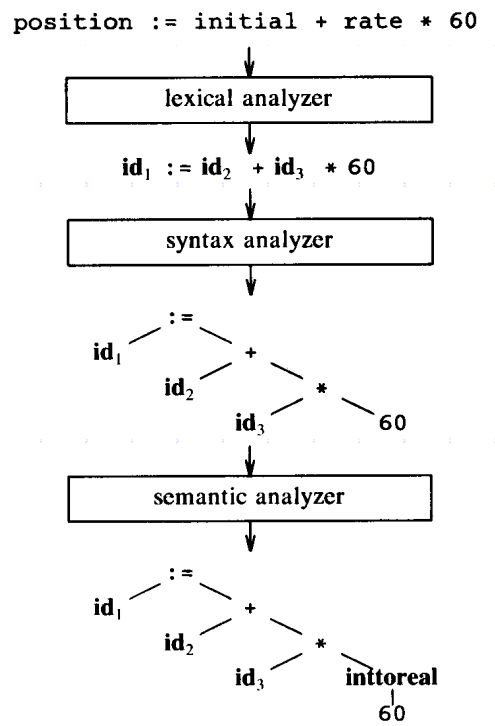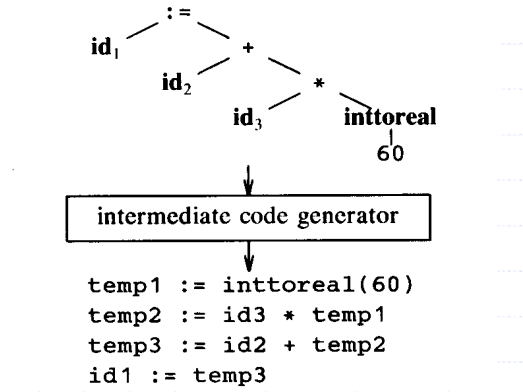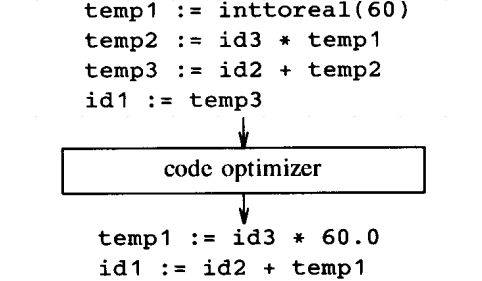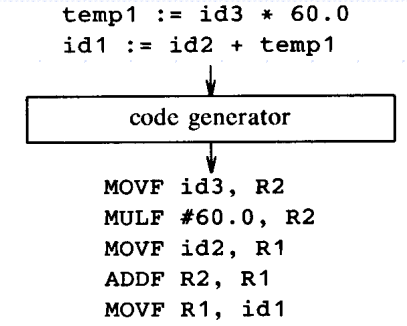Compiler 筆記 (1)
參考 清華大學 李政崑老師 編譯器設計講義
compilers and Assemblers
High-level language program (C)
⇒ C compiler
⇒ Assembly language program (for MIPS)
⇒ Assembler
⇒ Binary machine language program (for MIPS)
Analysis-Synthesis Model
Compilation 可以分成兩個部分
- Analysis (front end)
- Breaks up the source program into constituent pieces
- Creates an Intermediate Representation (IR)
- Synthesis (back end)
- Constructs the desired target program from the IR
- (Optionally) performs optimizations

Phase of a Compiler

Symbol-Table Management
- Essential function of a compiler
- To record the identifier used in the source program and collect information about various attributes of each identifier
- allocate storage, type, scope, etc
- To record the identifier used in the source program and collect information about various attributes of each identifier
- Symbol Table
- A data structure containing a record for each identifiers, with fields for the attributes
- When a identifier is detected by the lexical analysis(詞法分析) , it is entered into the symbol table
- The attributes are determined during syntax analysis(語法分析) and semanic analysis(語義分析)
Analysis Phases
- Lexical Analysis
- Syntax Analysis
- Semantic Analysis

Intermediate Code Generation
- Two properties
- Easy to produce
- Easy to translate into the target program
- Examples
- Graph representations
- Postfix notation
- Three-address code
- 每條指令最多有三個 operands

Code Optimization
- Attempts to improve the intermediate code
- So the faster-running machine code will result

Code Generation
- Generates target code
- Consisting of reocatable machine code or assembly code

Counsins of the compiler
- Preprocessors
- Produce input to compilers
- Macro processing
- File inclusion
- Assemblers
- Loaders and Link-Editors
Evolution of Programming Languages
Imperative language
- 命令式語言
- 指定程式該執行的確切操作
- Ex: C, C++, Java, Python
Declarative language
- 宣告式語言
- 只要所需的結果,而不是詳細指定要執行的步驟
- Ex: SQL, HTML, CSS, Prolog
Von Neumann language
基於 Von Neumann 電腦架構
Many widely used programming languages such as C, C++ and Java have ceased to be strictly von Neumann by adding support for parallel processing, in the form of threads.
Before C++ 11 added threads, C++ was strictly a Von Neumann language
Object-oriented language
- 繼承、封裝、多型
- Ex: Java, C++
Functional language
- 在一般常見的命令式語言中,要執行操作的話是給電腦一組命令,而狀態會隨著命令的執行而改變。例如你指派變數 a 的值為 5,而隨後做了其它一些事情之後 a 就可能變成的其它值。有控制流程 (control flow),你就可以重複執行操作
- 然而在純粹函數式程式語言中,你不是像命令式語言那樣命令電腦「要做什麼」,而是通過用函數來描述出問題「是什麼」,如「階乘是指從 1 到某個數的乘積」,「一個串列中數字的和」是指把第一個數字跟剩餘數字的和相加。你用宣告函數是什麼的形式來寫程式
- 另外,變數 (variable) 一旦被指定,就不可以更改了,你已經說了 a 就是 5,就不能再說 a 是別的什麼數
- Ex: Haskell、Scala、Clojure
1 | |
Assignment-oriented language
- 賦值操作來實現程式邏輯的語言
- Ex: C, Java,
- 反例: Haskell
Third-generation language
- 相對於機器語言和組合語言而言的高階程式語言
- Ex: C, Java, Python
Fourth-generation language
- 更高級、更抽象的程式語言,旨在簡化特定領域的應用程式開發
- 提供了更高程度的自動化和巨集
- Ex: SQL, MATLAB
Scripting language
- 一個指令碼通常是直譯執行而非編譯
- Ex: JavaScript、Perl、PHP、Python、Ruby 和 Tcl,
補充
如果是說 imperative programming 和 declarative programming,我查到的都是程式碼的寫法
- Imperative language
- 命令式編程
- 著重在 HOW,具體表達程式碼該做什麼才能達到目標,程式一步一步按著順序照著你給他指示執行。
- Imperative 比較常運用 Statement ,像是是 if, while, for, switch 等。
- You tell the compiler what you want to happen, step by step.
- Delcarative language
- 宣告式編程
- 著重在該做什麼 WHAT ,採取抽象化流程。Declarative 比較常運用表達式 expression,
- Delcarative 特色是單純運算並一定會有返回值
Example: choose the odd numbers
1 | |
With imperative programming, we’d step through this, and decide what we want:
1 | |
With declarative programming, on the other hand, you declare your desired results, but not the step-by-step:
1 | |
Source
- Buzz Word 1 : Declarative vs. Imperative
- What is the difference between declarative and imperative paradigm in programming?
Lambda Parameters
C++ 中,Lambda 架構是
1 | |
[ ] 空的捕獲列表,表示不捕獲任何外部變數
1 | |
[&] 按引用捕獲所有外部變數
1 | |
[=] 按值捕獲所有外部變數
1 | |
[=, &foo] 按值捕獲所有外部變數,但特別引用了 foo 變數
1 | |
[bar] 按值捕獲 bar 變數
1 | |
[this] 按值捕獲當前物件的指標(常用於 lambda 在 class 內部的情況)
1 | |
First Class Object
- Entity can be stored into a variable
- Something can be passed around as parameters
- In C language, structure and function are consider first class objects
Bindings
Static Binding
- 在編譯時期或者早期階段就確定呼叫哪個方法或函式
- Ex: C 的函式呼叫,它在編譯時期就將函式內容綁定到識別符上,而無法在執行時期變更。
Dynamic Binding
- 綁定發生在 runtime,而不是在編譯時
- Ex: C++ 的虛擬方法呼叫,由於多型的機制,物件的型別無法在編譯時期得知,所以綁定會在執行時期處理。
Fluid Binding
- AKA dynamic assignment
- Assignments with dynamic extent to bindings that have lexical scope
- Syntax
- var := expr during stmt-body
1 | |
Example
1 | |
Suppose static binding (also known as lexical binding) is used for variable scopes. What’s the printout value of y?
我猜 mess 裡面 i 是 1、a[i] 是 1,所以 y = 1 + 5 = 6
Suppose dynamic binding is used for variable scopes. What’s the printout value of y?
我猜 mess 裡面 i 是 2、a[i] 是 7,所以 y = 7 + 5 = 12
Parameter Passing Schemes
Call-by-reference
- Call 的瞬間就看 caller
- 在呼叫 function 的當下就已經決定好 parameter 的值
Call-by-name
- 用的時候重新看 caller
- 在呼叫的 function 當中每次使用到 parameter 就重新去檢查 caller 當中當下的值
Call-by-need
- 跟 call by name 很像,一樣去算 caller 的,但是第一次算完就存起來,不用每次都算
- 第一次使用時重新看 caller
- 在呼叫的 function 當中第一次使用到 parameter 的時候才去決定後續的值
Call-by-text
- 用的時候重新看 callee
- 在呼叫的 function 當中每次使用到 parameter 就重新去檢查 callee 當中當下的值
- 更好的理解方式是從名稱 “call by text”,意即 parameter 會以 text 的型態傳遞,因此需要把所有的 parameter 都視為傳遞前的原貌
- 例如定義
f(v: integer),呼叫f(a[i]),則f當中的每個v都需要替換成a[i]
Example
1 | |
- If by assuming Call-by-Text, what’s the value in the array a and the variable i?
| a[1] | a[2] | a[3] | i | v | |
|---|---|---|---|---|---|
| before mess | 0 | 10 | 0 | 2 | - |
| v := v + 1; | 0 | 11 | 0 | 2 | a[i] (a[2]) |
| a[i] := 5; | 0 | 5 | 0 | 2 | a[i] (a[2]) |
| i := 3 | 0 | 5 | 0 | 3 | a[i] (a[3]) |
| v := v + 1 | 0 | 5 | 1 | 3 | a[i] (a[3]) |
| observation point | 0 | 5 | 1 | 3 | - |
- If by assuming Call-by-Reference, what’s the value in the array a and the variable i?
| a[1] | a[2] | a[3] | i | v | |
|---|---|---|---|---|---|
| before mess | 0 | 10 | 0 | 2 | - |
| v := v + 1; | 0 | 11 | 0 | 2 | a[2] |
| a[i] := 5; | 0 | 5 | 0 | 2 | a[2] |
| i := 3 | 0 | 5 | 0 | 3 | a[2] |
| v := v + 1 | 0 | 6 | 0 | 3 | a[2] |
| observation point | 0 | 6 | 0 | 3 | - |
1 | |
- If by assuming Call-by-Name, what’s the value in the array a and the variable i?
| a[1] | a[2] | a[3] | i (caller) | i (callee) | v | |
|---|---|---|---|---|---|---|
| before mess | 0 | 10 | 0 | 2 | - | - |
| i := 1 | 0 | 10 | 0 | 2 | 1 | a[2] |
| v := v + 1; | 0 | 11 | 0 | 2 | 1 | a[2] |
| a[i] := 5; | 5 | 11 | 0 | 2 | 1 | a[2] |
| i := 3 | 5 | 11 | 0 | 2 | 3 | a[2] |
| v := v + 1 | 5 | 12 | 0 | 2 | 3 | a[2] |
| observation point | 5 | 12 | 0 | 2 | - | - |
- If by assuming Call-by-Text, what’s the value in the array a and the variable i?
| a[1] | a[2] | a[3] | i (caller) | i (callee) | v | |
|---|---|---|---|---|---|---|
| before mess | 0 | 10 | 0 | 2 | - | - |
| i := 1 | 0 | 10 | 0 | 2 | 1 | a[i(callee)] (a[1]) |
| v := v + 1; | 1 | 10 | 0 | 2 | 1 | a[i(callee)] (a[1]) |
| a[i] := 5; | 5 | 10 | 0 | 2 | 1 | a[i(callee)] (a[1]) |
| i := 3 | 5 | 10 | 0 | 2 | 3 | a[i(callee)] (a[3]) |
| v := v + 1 | 5 | 10 | 1 | 2 | 3 | a[i(callee)] (a[3]) |
| observation point | 5 | 10 | 1 | 2 | - | - |
- If by assuming Call-by-Need, what’s the value in the array a and the variable i?
| a[1] | a[2] | a[3] | i (caller) | i (callee) | v | |
|---|---|---|---|---|---|---|
| before mess | 0 | 10 | 0 | 2 | - | - |
| i := 1 | 0 | 10 | 0 | 2 | 1 | - |
| v := v + 1; | 0 | 11 | 0 | 2 | 1 | a[i(caller)] (a[2]) |
| a[i] := 5; | 5 | 11 | 0 | 2 | 1 | a[2] |
| i := 3 | 5 | 11 | 0 | 2 | 3 | a[2] |
| v := v + 1 | 5 | 12 | 0 | 2 | 3 | a[2] |
| observation point | 5 | 12 | 0 | 2 | - | - |
1 | |
- If by assuming Call-by-Name, what’s the value in the array a and the variable i?
| a[1] | a[2] | a[3] | i | v | |
|---|---|---|---|---|---|
| before mess | 0 | 10 | 0 | 2 | - |
| i := 1 | 0 | 10 | 0 | 1 | - |
| v := v + 1; | 1 | 10 | 0 | 1 | a[i] (a[1]) |
| a[i] := 5; | 5 | 10 | 0 | 1 | a[i] (a[1]) |
| i := 3 | 5 | 10 | 0 | 3 | a[i] (a[3]) |
| v := v + 1 | 5 | 10 | 1 | 3 | a[i] (a[3]) |
| observation point | 5 | 10 | 1 | 3 | - |
- If by assuming Call-by-Need, what’s the value in the array a and the variable i?
| a[1] | a[2] | a[3] | i | v | |
|---|---|---|---|---|---|
| before mess | 0 | 10 | 0 | 2 | - |
| i := 1 | 0 | 10 | 0 | 1 | - |
| v := v + 1; | 1 | 10 | 0 | 1 | a[i] (a[1]) |
| a[i] := 5; | 5 | 10 | 0 | 1 | a[1] |
| i := 3 | 5 | 10 | 0 | 3 | a[1] |
| v := v + 1 | 6 | 10 | 0 | 3 | a[1] |
| observation point | 6 | 10 | 0 | 3 | - |